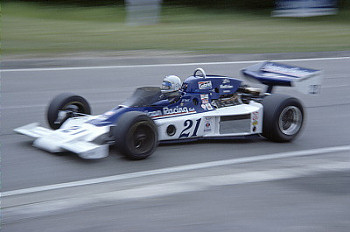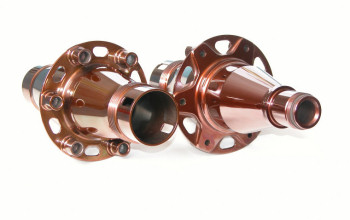The Way It Is/ Kenny Hill & his company Metalore make superb racing products
by Gordon Kirby This week and next, I'm going to take a look at Metalore. This company is justly considered one of the American racing industry's finest gems and it's because of dedicated little companies like Metalore that racing happens. Located in El Segundo, close to LAX, Metalore manufactures drivetrain components and wheel hubs, among other things, for top Formula 1 teams and other teams across the worldwide motor sport business.
This week and next, I'm going to take a look at Metalore. This company is justly considered one of the American racing industry's finest gems and it's because of dedicated little companies like Metalore that racing happens. Located in El Segundo, close to LAX, Metalore manufactures drivetrain components and wheel hubs, among other things, for top Formula 1 teams and other teams across the worldwide motor sport business.
Owned and operated by Kenny Hill, Metalore has been a highly respected supplier to major race teams for more than thirty years. Included among its customers at various times have been Ferrari, McLaren and Benetton in F1, and Penske, Newman/Haas, All American Racers, Ganassi and Rahal in CART.
Today, Metalore continues to supply three F1 teams with driveline and wheel hub components and also Champ Car as a whole with similar pieces for this year's new Panoz spec car. As far as F1 is concerned, Hill believes he's struck the right balance of business.
"We've had virtually every one of the Formula 1 teams at some point in time," Hill said. "We're down to three right now, but they've been very good customers. We've got about three and a half F1 teams we do a lot of work for and that seems to be about the right number to keep the pressure on us all day long and for us to cater to them enough to keep production going two shifts and six days.
"At one point in time, having five or six or seven teams in here, that was too much. So I think right now we're just about as good as it could get in a job-shop operation."
Metalore was founded back in 1960 by Hill and two partners to build high-tech components for the aerospace industry. Hill became the company's sole owner in 1980 and by that time Metalore already was expanding into automobile racing, starting by building driveline pieces for the Vel's Parnelli Jones USAC team. Over time the company's racing business has increased progressively so that racing today represents ninety percent of Metalore's business. Hill looks back fondly on his formative days in big-time racing in 1975 and '76 with the VPJ team and the revolutionary, Cosworth-powered Parnellis designed by John Barnard.

© LAT USA
"Vel's Parnelli built their own engines as well," Hill added. "They developed the Cosworth turbo engine and there were guys like Bill Eaton who could build anything. So they were doing their own cars and their own engines and it was great fun. It was a tremendous amount of work, but fun stuff, and I thought it was the real pinnacle of racing."
Hill was friendly with engine builder Ryan Falconer who built VPJ's Formula 5000 engines and Falconer got Hill into racing by introducing him to VPJ team manager Jim Chapman. In turn, Chapman introduced Hill to young design engineer John Barnard who had been drafted by the team to sort out the prototype, F1-based Parnelli-Cosworth Indy car.
"Jim Chapman was the one who found me one day through Ryan Falconer," Hill said. "They needed somebody who could keep their mouth shut and to this day that theory still functions pretty good. A few months ago, one of the colleges in this area called and wanted to come in here with a research team. It was very flattering, but I thought about it and decided, no. We keep high security. That's the way it's always been.
"Really, essentially, that's what our whole concept has always been. We've got to keep everybody's information proprietary to each team. At some point in time we've had seven or eight F1 teams in here simultaneously. It's a fine line to walk."
Hill provided an example of how he often walks a tightrope. "Sometimes, you know full well that this team wants to go down a path that another team tried three years ago and failed," he commented. "So you look at them and ask one more time, 'Are you really sure you want to make these parts this way?' And if they say yes, then I'm exempt from going any further, and we'll make the parts. That's the way we've always operated and it's an important reason why we continue in the business after thirty or thirty-five years. It's critical."
Highly-acclaimed race car designer John Barnard has nothing but praise for Hill and Metalore. "Kenny is just part of racing now," Barnard remarked. "We go back to about 1975 when I went around and asked him to make some hubs for the Parnelli. He was so dedicated to making a perfect part and he still is. He invests a lot of money in new machines just to get his pieces that little bit better all the time. And apart from that, he's a racer. He gets it done and his work is nothing less than superb."
Thirty years ago Hill made a good living in the aerospace industry but when Chapman and Barnard brought him into racing he had come to the point where he was itching to get away from a life dominated by government bureaucracy.
"I was so tired of aerospace and NASA contracts," Hill remarked. "It was so much hard work with the paper trail. We had half a building full of people pushing paper. It wasn't pleasurable and it wasn't fun. I had loved racing since I was a kid and the more I saw of it, the more I wanted to be involved."
Metalore's successful work for VPJ opened the door to F1 work. Barnard became a big proponent of Metalore products and he introduced Hill first to McLaren and later to Ferrari and Benetton.
"We started doing work with JB and Parnelli in '75 and then we started doing Formula 1 work seasonally," Hill recalled. "We started doing a lot of McLaren work in 1982. But then in '89 I made a conscious effort to make a fifty-two-week year of it, and I've never looked back."
Hill manufactured a six-ball ceramic CV joint in 1989 and began selling them to most CART teams. "I can recall shipping some to Foyt with a note saying, put these in and if you don't like them, here's a return FedEx receipt. It won't cost you anything to send them back. He was the last guy I couldn't sell on them and to this day we still have Foyt as a customer."

© Metalore
Through the nineties, Metalore's F1 and CART business boomed, augmented by the Dino Paoli wheel gun business. "In 1992 or '93, we became involved with Dino Paoli's wheel guns and we became their North American distributor," Hill explained. "I just wanted to make a decent wheel nut and they came up with the concept of a splined nut, and we started building it. I didn't want to be in the wheelgun business but it's ended up being a good portion of our sales this year. We have probably two-thirds of the Formula 1 wheel nut and socket business tied-up.
"We do a lot of work for Dino Paoli," Hill added. "He sells the guns and we supply him with all the titanium sockets and nuts. We've done some things for Alex Gurney's Grand-Am team trying to tune them up and get their stops a little bit quicker. And we're doing a lot for Honda motorcycle as well, valve train components, and such, for stadium racing. We're also doing some pit equipment for them."
The wheel nut for the Dino Paoli gun was designed by veteran racing car and component designer Gordon Kimball who worked with Barnard for a number of years when Barnard's GTO company was the design house for Ferrari's F1 cars. Before that Kimball designed Wildcat Indy cars and was later responsible for one of the final Toyota-powered Eagle Champ cars. Eventually, Kimball and Barnard argued bittterly and went their separate ways. Kimball continues these days as a part-time design consultant to Metalore.
"Gordon Kimball is not on my payroll but he's damn close to it," Hill remarked. "He's a great guy. I'm always looking for something new to do and I'm always looking for something for Gordon to work on.
"Gordon is as good as anybody I've ever seen, including JB," Hill continued. "John would always have the ideas and then Gordon would have to work out the details. I've gotten into some big wars with both of them and I've said to them that as far as I'm concerned the best motorsports there ever was was when they were together. I know because I made the hardware.
"I tried to get them back together and be the arbitrator in the middle of it and I got my toes stubbed. But I had to give it a go because those guys to this day were the best, without any queston. The two of those guys inside one design office were absolutely astounding, meaning JB with a clean sheet of paper and Gordon doing all the detail work."
Hill points out that the history of technological development is full of odd couples going back to before the industrial revolution. "When you look back there are others, like Mario Ilien and Paul Morgan--the thinker and the steady guy. I think if you look back through history that goes back hundreds of years, to be honest. You need the guy who is an abstract thinker who can take it from a clean sheet of paper, and then the detail guy who makes it happen."
By the way, an interesting Metalore project from this year was a complex, Kimball-designed, adjustable rear wing manufactured specifically for the Indy 500. We can only report that the wing was used to great effect by one of the top teams.
"I can't say anything about it other than it was great fun," Hill said wearing his best Cheshire cat grin. "It was very complicated, but it worked really well and I think it helped beause it was on all the frontunners at Indy."
We'll continue our discussion of Metalore's role in racing next Monday wherein Kenny Hill will offer his thoughts about spec car racing, today's manufacturer-driven Formula 1, the government's changing procurement system, and how he gets the best out of his little gem of a business.
Auto Racing ~ Gordon Kirby
Copyright 2007 ~ All Rights Reserved
Copyright 2007 ~ All Rights Reserved
Top of Page